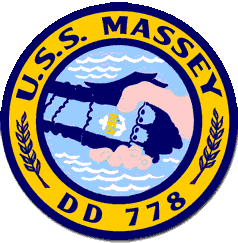USS MASSEY DD 778, an ALLEN SUMNER DD 692 Class destroyer, on commissioning had a displacement of 2,200 tons; waterline length of 376’6’’; beam of 41’1’’; and a draft of draft 15’8”. Her armament included six twin 5”/38 dual purpose main batteries, twelve twin and quad 40mm, and eleven 20mm gun mounts; ten 21” torpedo tubes; two depth charge racks (600lbs); six single K-Gun depth charge mounts (300lbs). Her propulsion plant included four boilers; two sets of steam driven, geared turbines; two shafts/screws/rudders providing the ship with 60,000 shaft horsepower for a top speed of speed 34 knots. MASSEY’s wartime complement numbered 336 officer and enlisted personnel.
MASSEY (DD 778) was laid down 14 January 1944 by Todd Shipyard, Inc., Seattle, Washington; launched 12 September 1944; sponsored by Mrs. Lance E. Massey, widow of Lieutenant Commander Massey; and was commissioned 24 November 1944. Commander Charles W. Aldrich served as the commissioning Commanding Officer with LCDR Ray Zoeller as Executive Officer.
The ship conducted many tests at dockside and underway, departing for San Diego on 12 December. Here she underwent six weeks of various drills and inspections. Unfortunately during a high-speed maneuver with other vessels one of our crewmen happened to be at the wrong place on the fantail and received fatal injuries as a wall of water flung him to the deck. Calvin F. Queen was the only sailor to lose his life aboard the MASSEY. The ship returned to Bremerton Navy yard for a post-shakedown overhaul on completion of sea trials.
On February 13th the MASSEY weighed anchor and steamed through the Straits of Juan de Fuca with Pearl Harbor as her initial destination. For the first month of the Okinawa campaign, MASSEY served with a task force of four escort carriers in raids on the Sakishima Islands. Then followed seven weeks of radar picket duty around Okinawa in company with one or more destroyers such as the four ships of Destroyer Squadron 132, ZELLARS (DD 777), MASSEY (DD 778), D.H. FOX (DD779), and STORMES (DD 780).
Kamikaze planes took the lives of seventy-two men of this squadron in April and May. Even with frequent attacks by kamikaze planes, the combination of able maneuvering by Captain Aldrich, expert aircraft identification by her radarmen, and excellent shooting by her gunners, brought her through unscathed and with no loss of life. The MASSEY accounted for nine kamikaze planes in all, five of which fell before her guns in one evening of engagement.
With the collapse of organized Japanese resistance on Okinawa, most picket destroyers received new assignments. On June 24 the MASSEY departed for San Pedro Bay, Leyte Gulf, Philippine Islands with Destroyer Squadron 24. After a brief repair period, she served as part of a carrier screen off the China coast. The MASSEY steamed into Japanese water on 22 September as part of the first American landings at Wakayama.
On 20 November 1945 CDR. Don. I. Thomas relieved CDR Charles. W. Aldrich. The ship then operated with other destroyers of Squadron 66 on weekly patrols to Yakoska Bay of Tokyo. She continued this duty until the squadron departed for San Diego on December 5, traveling by way of Eniwetok, Marshall Islands and Pearl Harbor. She arrived San Diego 22 December 1945. After 14 months at war, all hands had a very merry Christmas at home.
For her time in WW II, the MASSEY earned two Battle Stars on the Asiatic-Pacific Area Service Ribbon, for participating in the following operations:
• Star/Okinawa Gunto operation
• Assault and occupation of Okinawa - 24 March to June 1945.
• Star/ THIRD Fleet operations against Japan -10 July to 15 August 1945.
USS MASSEY was assigned to Destroyer Squadron 2 in the Atlantic Fleet and on 3 January 1946 left for New York for major repairs. In June 1946 the ship finished an overhaul in the Brooklyn Naval Shipyard. From 6 July until 1 November, the ship operated from the North Atlantic to the British West Indies area doing various escorting, shore bombardment, screening exercises and at sea drills. Her assignments included midshipman summer cruises. The 1946 summer Middie cruise was followed by a visit to Chile, and hunter-killer team exercises for the Navy’s Operational Development Force.
Christmas 1946 was spent in Charleston, South Carolina. During this period, CDR Forrest M. Price relieved CDR Don Thomas. Captain Price had symptoms of tuberculosis and was temporarily relieved by the Executive Officer- LCDR A. R. Evers. After a two-months of hospital tests, Captain Price returned but when ordered back to the hospital for treatment, CDR Alan Nibbs took command. The date could have been be early 1947.
Twice during 21 July to 19 November 1947 and 1 June to 3 October 1948, she deployed to the SIXTH Fleet in the Mediterranean.

